A 12-day-old boy with a rash
A 12-day-old male neonate was admitted to the hospital for evaluation and treatment of a rash. The history of this rash began two days earlier when the mother noted the appearance of three crusted spots on the baby’s chest. Within 24 hours, he had many more lesions with vesicles on erythematous bases. There had been no history of fever or unusual behavior. His appetite had not changed.
Examination upon arrival revealed normal vital signs and a normal-appearing, 12-day-old male with the rash described above, as well as a generalized maculopapular rash involving the face and trunk with much confluence similar to a morbilliform pattern, as shown in figures 1–4. The rest of his examination was normal. Specifically, there was no mucous membrane or eye inflammation or other abnormal findings.

Pediatric Infectious Disease, Scott and White's Children's Health Center and Associate Professor of Pediatrics,
Texas A&M University, College of Medicine, Temple, Texas.
e-mail: jhbrien@aol.com
Lab tests included a full sepsis workup; complete blood count, electrolytes, liver enzymes, renal function tests, urinalysis, and spinal fluid analysis with cultures of all body fluids pending. All preliminary tests, including a chest radiograph, were normal. Polymerase chain reaction (PCR) for herpes simplex virus (HSV) on the spinal fluid was negative, but positive on skin lesions (HSV type 2).
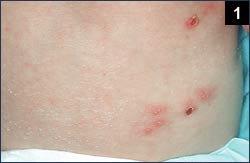
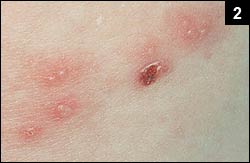
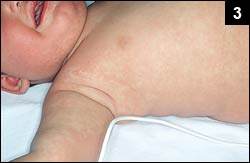
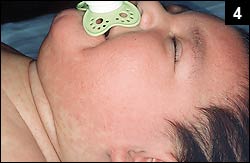
He was diagnosed with the skin-eye-mouth (SEM) type of neonatal herpes simplex infection and received a 14-day course of intravenous acyclovir at 60 mg/kg per day divided every eight hours, and was discharged home in good condition. However, within four days, some of the vesicular lesions returned in the same location. He was then treated with oral acyclovir for another two weeks. The rash resolved with the acyclovir, but reoccurred within a week of stopping the acyclovir. This cycle seemed to repeat every month, and always limited to the skin.
The diagnosis is recurrent cutaneous HSV infection.
What’s your treatment?
- Oral valacyclovir prophylaxis
- Oral acyclovir with flair-ups
- Oral acyclovir prophylaxis
- Admission & IV acyclovir with flair-ups
Answer
My answer is C, oral acyclovir prophylaxis.
However, some may say, “but my answer is not up there, as I would do nothing as long as it is uncomplicated recurrences confined to the skin.” However, those of you who have been faced with this problem, you know that the parents will usually not accept that option. And even if the area can be covered, most day care facilities will not allow the baby or child back in until the problem is resolved.
Another concern is the fact that babies who have recurrent HSV skin-eye-mouth (SEM) disease are more likely to have measurable neurologic deficits than their age-matched peers (learning disabilities, seizures, cerebral palsy, etc.). However, having said that, I am not aware of any scientific evidence that preventing these mucocutaneous recurrences with chemoprophylaxis (acyclovir) for six months prevents these associated neurological complications. But at least preventing the SEM recurrences will allow the child to avoid the misery of these episodes and allow the family to enjoy a more normal life.
If oral prophylaxis is to be done, according to research by the NIAID Collaborative Antiviral Study Group, a dose of 300 mg/m² (about 10 mg/kg for the average child) given three times per day can be used for six months. The 2006 Red Book guidelines suggests a higher dose of 80 mg/kg/day divided into three doses for up to a year.
Whichever dose you use, this should only be done if the baby can be closely monitored. Up to half of these patients will develop significant neutropenia, which may require stopping or at least reducing the dose of acyclovir to perhaps twice a day. Their renal function should also be monitored. Any renal insufficiency will require an adjustment in the dosing of the acyclovir as well.
Although this infection can occur anywhere on the body, the face is a common site for this problem to occur in neonates, which start out with a primary infection much like that seen in figures 5 & 6. However, older children can also have troublesome recurrences of cutaneous HSV after a primary as shown in figure 7. A patient referred to me with recurrent facial HSV is shown in figures 8 & 9. After the visit shown in figure 9, she was placed on acyclovir prophylaxis for six months with good results and no recurrences over the last several years.
The choice of valacyclovir, which is often used in adults for recurrent HSV infections, is not FDA-approved for children. It is a prodrug of acyclovir that is converted into acyclovir after absorption, but simply has not been adequately studied in children.
Finally, the generalized maculopapular rash noted in the patient presented probably represented a viral exanthem due to the HSV, as it resolved with the primary episode, and I cannot think of any other reason the baby would have had the rash. HSV is not listed as one of the common causes of a morbilliform rash, but certainly other herpes viruses are associated with this type of eruption. Let me know if you have any experience or other ideas with this.
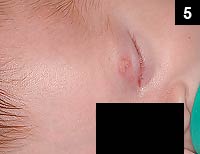
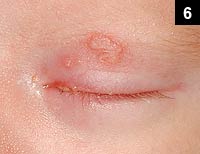
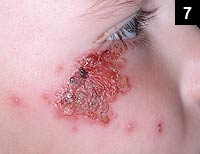
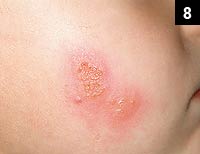
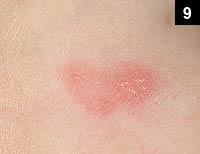
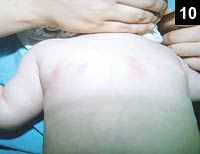
Columnist comments
Under the direction of Dr. Richard Whitley, the director of the division of pediatric infectious diseases at the University of Alabama School of Medicine in Birmingham, the NIAID Collaborative Antiviral Study Group has contributed the vast majority of the information used to advance the treatment and prophylaxis of neonatal HSV infections being used today, and is responsible for immeasurable benefits to those babies infected with this potentially lethal virus.
In fact, Dr. Whitley’s UAB pediatric infectious diseases division is known worldwide for their virology research, with staff such as Robert Pass, David Kimberlin, Wayne Sullender, William Britt and others with special interest in viral diseases. I have called on Richard Whitley and David Kimberlin on many occasions over the years when I have been faced with an unusual problem related to babies or children with HSV infections. Dr. Whitley advised me on the first baby that I saw with recurrent cutaneous HSV, which happened to be on his chest (figure 10) in the mid 1980s, when I was a relatively new pediatric infectious disease staff at Brooke Army Medical Center in San Antonio. His advice for prophylaxis was clear, easy to follow, and it worked. You can tell by the quality of the picture that it was a long time ago, and one I took myself early in my career. But it makes the point. That baby had been excluded from his daycare center so many times that it was having a detrimental effect on the parents’ work and their family life. Placing the baby on prophylaxis made a huge difference. I was able to follow the baby for over a year, and he never had another recurrence during that time.
Please keep in touch, remember our brothers and sisters in arms, and Happy Rosh Hashanah.
What’s Your Diagnosis? is a monthly case study featured in Infectious Diseases in Children, with treatment information and discussion to follow.
